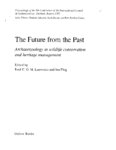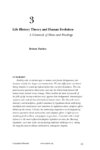|
|
Creator | Title | Description | Subject | Date |
| 51 |
 |
Broughton, John | Homestead cave Ichthyofauna | Biological evidence on the climatic and hydrographic history of the intermountain region would be much richer, if we had more than the present dribble of paleontological data on the fishes (Hubbs and Miller, 1948, p. 25). In this passage from their landmark synthesis of historical fish biogeograph... | Homestead Cave; Ichthyofauna; Lake Bonneville | 2000 |
| 52 |
 |
Rogers, Alan R. | Pleistocene population X-plosion? | In two recent papers, Kaessmann et al. presented DNA sequence data from the X chromosome (Xq13.3) of 30 chimpanzees and 69 humans (Kaessmann et al. 1999a; Kaessmann et al. 1999b). These data bear on two longstanding questions involving late Pleistocene demographic history: (1) whether the long-term... | | 2000 |
| 53 |
 |
Hawkes, Kristen | Hunting and the evolution of egalitarian societies: lessons from the Hadza | Political hierarchies are common in human societies but absent among many mobile hunter-gatherers. So egalitarian social organizations have been attributed to limits that foraging imposes on wealth accumulation. But male-dominance hierarchies characterize all the great apes, our nearest relatives. ... | | 2000 |
| 54 |
 |
McElreath, Richard | In search of homo economicus: behavioral experiments in 15 small scale societies | Recent investigations have uncovered large, consistent deviations from the predictions of the textbook representation of Homo economicus One problem appears to lie in economists' canonical assumption that individuals are entirely self-interested: in addition to their own material payoffs, many exper... | Economic behavior; Self-interest; Fairness; Reciprocity | 2001 |
| 55 |
 |
Broughton, John | Resource intensification and late Holocene human impacts on Pacific coast bird populations: evidence from the Emeryville shellmound avifauna | Anthropologists and conservation biologists have commonly assumed that the distributions and abundances of vertebrate resources recorded during the early historic period in North America reflected a "pristine" condition. This view follows from the perception that Native American population densities... | Resource intensification; Holocene human impacts; Foraging efficiency; Harvest pressure; Bird populations; Emeryville shellmound | 2001 |
| 56 |
 |
Hawkes, Kristen | Why hunter-gatherers work: An ancient version of the problem of public goods | From the abstract: People who hunt and gather for a living share some resources more widely than others. A favored hypothesis to explain the differential sharing is that giving up portions of large, unpredictable resources obligates others to return shares of them later, reducing everyone's variance... | Hunter-gatherer societies; Public goods | 2001-08 |
| 57 |
 |
Rogers, Alan R.; Harpending, Henry C. | Genetic structure of ancient human populations | Discusses mitochondrial DNA (mtDNA) sequences as important source of data about the history of human species. | Tree of descent; Mismatch distributions; Simulations; Findings; Intermatch distributions; Younger and older populations | 2001-09-15 |
| 58 |
 |
Hawkes, Kristen | Hunting and nuclear families: some lessons from the Hadza about men's work | Hadza hunter-gatherers display economic and social features usually assumed to indicate the dependence of wives and children on provisioning husbands and fathers. The wives and children of better Hadza hunters have been found to be better-nourished, consistent with the assumption that men hunt to pr... | Subsistence economy; Tindiga, African people; Subsistence hunting | 2001-10-24 |
| 59 |
 |
McElreath, Richard | Can females gain additional paternal investment by mating with multiple males? a game theoretic approach | Although females may require only one mating to become inseminated, many female animals engage in costly mating with multiple males. One potential benefit of polyandrous mating is gaining parental investment from multiple males. We developed two game theoretic models to explore this possibility. Our... | Female multiple mating; Polyandry; Nonprocreative mating; Paternal investment; Mating benefits; Mating strategy | 2001-11 |
| 60 |
 |
McElreath, Richard | Are peasants risk-averse decision makers? | For decades, researchers studying small-scale, subsistence-oriented farmers have sought to explain why these "peasants" seem slow to acquire new technologies, novel agricultural practices, and new ideas from the larger societies that have engulfed them. The early work on this question suggested that... | Subsistance farmers; Risk-aversion; Risk-taking; Cultural conservatism; Cost-benefit analysis | 2002 |
| 61 |
 |
Wiessner, Pauline W. | Vines of complexity - egalitarian structures and the institutionalization of inequality among the Enga | The initial stages of the institutionalization of hierarchical social inequalities remain poorly understood. Recent models have added important perspectives to "adaptationist" approaches by centering on the agency of "aggrandizers" who alter egalitarian institutions to suit their own ends through de... | Egalitarian structures; Political evolution; Social d | 2002-04 |
| 62 |
 |
Hawkes, Kristen | Human life histories: primate trade-offs, grandmothering socioecology, and the fossil record | Human life histories differ from those of other animals in several striking ways. Recently Smith and Tompkins (1995, p. 258) highlighted the combination of "slow" and "fast" features of human lives. Our period of juvenile dependency is unusually long, our age at first reproduction is late, and we h... | Meat; Maturity; Life Span | 2003 |
| 63 |
 |
McElreath, Richard | Shared norms and the evolution of ethnic markers | Unlike other primates, human populations are often divided into ethnic groups that have self-ascribed membership and are marked by seemingly arbitrary traits such as distinctive styles of dress or speech (Barth 1969, 1981). The modern understanding that ethnic identities are flexible and ethnic bou... | Ethnic groups; Ethnic identity; Migration; Markers | 2003-02 |
| 64 |
 |
Rogers, Alan R. | Genetic variation at the MCIR Locus and the time since loss of human body hair | The melanocortin I receptor (MCIR) locus makes a protein that affects the color of skin and hair. At this locus, amino-acid differences are entirely absent among African humans, abundant among non-Africans (especially Europeans), and abundant in chimpanzee/human comparisons (Rana et al. 1999, Hardin... | Nonsynonymous; Chimpanzee; Constraint | 2004 |
| 65 |
 |
Broughton, John | Prehistoric human impacts on California birds: evidence from the Emeryville Shellmound Avifauna | The abundance of artiodactyls, marine mammals, waterfowl, seabirds, and other animals in 18th- and 19th-century California astonished early explorers, and the incredible wildlife densities reported in their accounts are routinely taken as analogues for the original or pristine zoological condition. ... | Avifauna; Prehistoric hunting; Biological evaluation of environmental impacts | 2004 |
| 66 |
 |
McElreath, Richard | Social learning and the maintenance of cultural variation: an evolutionary model and data from East Africa | Human societies maintain between-group variation despite mixing of people and ideas. In order for variation to remain, migrants or their children must preferentially adopt local norms, customs, and beliefs. Yet the details of how cultural variation is maintained, despite mixing, remain unknown. This... | Cultural variation; cultural identity; East Africa | 2004 |
| 67 |
 |
Broughton, John | Pristine benchmarks and indigenous conservation? Implications from California zooarchaeology | The superabundance of tame wildlife during the early historic period in California astonished European explorers. And the historic accounts of incredible animal densities, most notably artiodactyls, have influenced a long-held perception that California Indians lived in harmony with nature. However,... | | 2004-01-01 |
| 68 |
 |
McElreath, Richard | Economic man in cross-cultural perspective: behavioral experiments in 15 small-scale societies | Since "Selfishness examined . . ." (Caporael et al. 1989) appeared in these pages, more than 15 years ago, many additional experiments have strongly confirmed the doubts expressed by Caporael and her collaborators concerning the adequacy of self-interest as a behavioral foundation for the social sci... | Economic outcomes; Selfishness; Fairness; Reciprocity | 2005 |
| 69 |
 |
Rogers, Alan R.; Jorde, Lynn B. | Modeling the amplification dynamics of human Alu retrotransposons | Retrotransposons have had a considerable impact on the overall architecture of the human genome. Currently, there are three lineages of retrotransposons (Alu, L1, and SVA) that are believed to be actively replicating in humans. While estimates of their copy number, sequence diversity, and levels of ... | Retrotransposons; Amplification dynamics; Mutation; Human-chimpanzee divergence | 2005 |
| 70 |
 |
Broughton, John | Fish remains dominate Barn Owl pellets in northwestern Nevada | The foraging ecology of the Barn Owl (Tytoalba) has been studied extensively, both in the New World (Marti 1988, Castro and Jaksic 1995, Van Vuren and Moore 1998, and others) and the Old World (Glue 1967, Yom-Tov and Wool 1997, and others). Small rodents, insectivores, and small birds are generally ... | Barn Owl pellets; Northwestern Nevada; Fish; Fish remains | 2006 |
| 71 |
 |
O'Rourke, Dennis H. | Hrdlič̌ka's Aleutian population-replacement hypothesis: a radiometric evaluation | In a 1945 monograph, Hrdlička argued that, at 1,000 BP, Paleo-Aleut people on Umnak Island were replaced by Neo-Aleut groups moving west along the island chain. His argument was based on cranial measurements of skeletal remains from Chaluka Midden and mummified remains from Kagamil and Ship Rock b... | Population replacement; Paleo-Aleuts; Neo-Aleuts | 2006 |
| 72 |
 |
Hawkes, Kristen | Life history theory and human evolution : a chronicle of ideas and findings | Fertility ends at similar ages in women and female chimpanzees, but humans usually live longer and mature later. We also differ from our closest living relatives in weaning infants before they can feed themselves. The comparisons pose questions about when and why the distinctively human life history... | | 2006-01-01 |
| 73 |
 |
Hawkes, Kristen | The derived features of human life history | This chapter compares and contrasts the life histories of extant great apes in order to construct a hypothetical life history of the last common ancestor of all great apes and to identify features of human life history that have been derived during the evolution of our lineage. Data compiled from th... | | 2006-01-01 |
| 74 |
 |
Rogers, Alan R. | How much can fossils tell us about regional continuity? | Presents a study on the genetic contribution of earlier populations to later populations within regions called regional continuity. Testing for regional continuity with multiple characters; Replacement of archaic population by a population of modern humans. | Human genetics; Fossils; Regional continuity | 2006-06-05 |
| 75 |
 |
Cashdan, Elizabeth A. | Ethnocentrism and xenophobia: a cross-cultural study | Analyzes the factors influencing ethnic affiliation and interethnic hostility. Relationship between intraethnic loyalty and risk of famine; Continuity of violence at different levels of groupings; Analysis of local and intercommunity conflict. | Ethnic relations; Ethnology | 2006-06-06 |

























